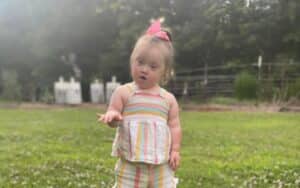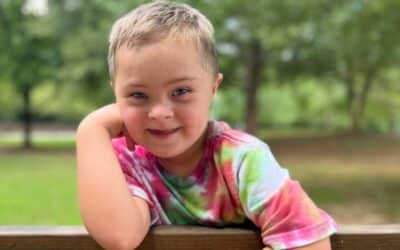Pointing is one of the first and most essential non-verbal communication tools a child learns. Often dismissed as a mere gesture, pointing plays a crucial role in the formative stages of a child’s speech, language, and communication development. In this article, we will answer the question, “How does pointing help a child’s language development?”

A Precursor to Verbal Communication
Before a child can articulate words, they communicate their needs, interests, and observations through gestures. Reaching usually comes first, followed by pointing. Pointing stands out as the primary means of drawing attention. By pointing, a child signifies desire and/or their interest in an object or event, laying the foundation for vocabulary building and word association. Every time a parent or caregiver responds to a child’s pointing gesture, the child begins to understand the importance of communication.
Enhancing Joint Referencing and Attention
Joint referencing and attention are pivotal milestones in child development. They involve two people sharing interest in an object or event. Pointing accelerates the development of joint attention. When a child points, and an adult looks or comments on the pointed object, the child recognizes shared focus. This mutual understanding strengthens the connection and interaction between the child and the caregiver, reinforcing positive communication behaviors.

Facilitating Speech and Language Development
Every time a child observes someone pointing or points themselves, there’s an opportunity for language growth. As the child listens to someone naming and talking about what they see, they participate in a language lesson in real-time. The child learns to associate the person, object, action, or situation with its name, thus expanding their vocabulary. As the child’s vocabulary grows, so does their understanding of the world around them.
Promotion of Social Interaction
Through pointing, children not only communicate with their primary caregivers but also with their peers. By sharing interests, directing attention or requesting through pointing, they foster social interactions. These early interactions, initiated by pointing, set the stage for more complex social communications in the future, such as sharing, conversing, negotiating, and problem-solving.
Stimulating Cognitive Development
Pointing isn’t just about communication; it’s closely tied to cognitive development. When children point, they can show awareness, understanding, desire, and curiosity about the world around them. Responding to their pointing allows caregivers to validate a child’s communication efforts and encourages the child to use pointing as a communication tool which sets the stage for the more advanced communication to come.
Nurturing Emotional Expressions
Besides conveying interest, pointing is a way for children to express emotions. For example, a child might point at a toy they desire or an event that excites or scares them. By acknowledging these pointing gestures, caregivers can better understand and respond to the child’s emotional needs, promoting their sense of security and well-being.
Strategies and Activities to Foster Pointing

- Model Pointing During Daily Routines: From infancy onward, point to, name and describe items, people, actions, and situations within your child’s environment.
- Sample activity: During mealtime prep, point to and name the items in the kitchen. Point to and name the child’s food.
- Interactive Reading: Choose picture-heavy books and point at different objects, naming them. Model pointing and naming. If your child tries to imitate you, show excitement about their effort. If not, keep modeling.
- Sample Activity: Play “Find the…” while reading. For instance, say, “Where is the dog” you point to it and repeat question, wait for your child to point it out. If they do, show excitement and if not keep modeling.
- Toy Play: Place two familiar toys or objects in front of your child and point at one, naming it. Celebrate if they attempt to or actually imitate your pointing. If not, keep modeling.
- Sample Activity: Create a toy hide and seek game. Hide a toy and ask, “Where’s the teddy?” and point to where it’s partially visible.
- Nature Walks: Go on walks and point out and name various animals, plants, rocks, vehicles, houses, etc.
- Sample Activity: Have a ‘Nature Treasure Hunt’ where you model pointing and encourage your child to find and point out specific things during the walk.
- Mirror Games: Using a mirror, point at and name 2-3 different facial body parts, encourage your child to do the same. If they do not, model this for a few minutes each day.
- Sample Activity: Play “Where’s your nose?” Model, model, model and give your child opportunity to point to their nose or your nose while looking in the mirror together.
FAQs
- What age do children typically start pointing?
- Most children begin pointing between 9 and 14 months of age.
- Is a delay in pointing always a cause for concern?
- While many children start pointing around their first year, it’s essential to consider other factors. Some children may not have the motor control to point. If a child is not pointing but engaging in other forms of communication or reaching other language milestones, it may not be a concern. However, any concerns should be discussed with a pediatrician and speech-language pathologist.
- Can pointing be encouraged or taught?
- Absolutely! Here are a couple of ideas. Consistently model pointing while naming objects and pictures and consistently offer your child two choices. Respond and give your child the item they looked at, reached for or pointed to when offered a choice.
- Does every child go through a pointing phase?
- While many do, some children might skip or have a less pronounced pointing phase, especially if they have physical difficulties or find other effective ways to communicate.
Additional Resources
- Are Gestures Important for Communication Development? – Help Your Child 2 Talk
- Social Communication Benchmarks (asha.org)
- Zero to Three: What are You Pointing At Baby?
- Hanen Centre: What’s the Point of Pointing
Summary/Conclusion
In the intricate journey of speech and language development, pointing emerges as key. This humble gesture paves the way for more advanced levels of communication, enriches social interactions, and nurtures cognitive and emotional growth. Modeling and recognizing and responding to a child’s pointing is not just about acknowledging their present needs; it’s about investing in their future communication skills.
As parents, caregivers, and educators, understanding the profound impact of pointing can truly make a difference in a child’s developmental trajectory. Embrace every pointing moment as an opportunity to connect, teach, and nurture.




0 Comments